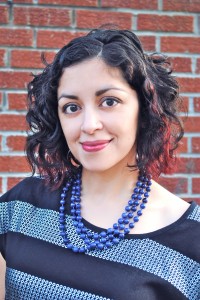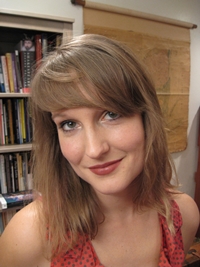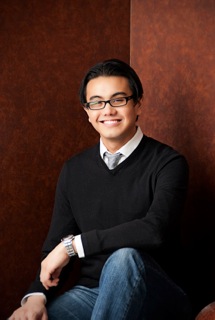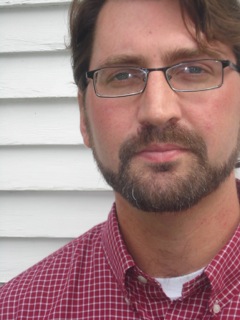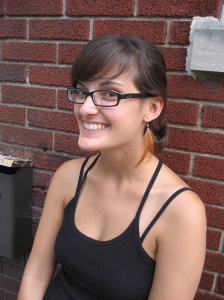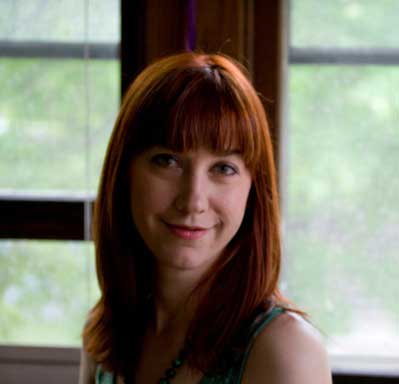Because the Essay Can Do So Much
Recognized for her richly poetic digressions yet startling precision, Lia Purpura doesn’t disappoint in her most recent collection of essays, A Rough Likeness. It’s an exciting excursion from one essay to the next as Purpura’s meditations move from the quest for meaning to the very act of meaning-making. I raced to get a copy of A Rough Likeness and slowed down while reading it only to savor the strange and inevitable beauty of the language. Marked with images both sparkling and haunting, these essays dwell in the mystery of nearly forgotten histories, shards of stories, beach glass, memories. Purpura writes “Without a story, the fragments won’t settle,” and while her essays demonstrate the veracity of this statement, outside of them some things are settled: Lia Purpura’s essays are fiercely elegant yet filled to the brim with guilty pleasures.
As satisfying as the book is, I was also interested in getting a few other things settled, particularly regarding her writing process and the creative choices that she made while putting this collection together.
Kathleen Blackburn: In your essay, “The Lustres,” you write “One summer night, when I was six and put to bed while the sun still shone and the game in the street went on without me, I thought to myself, framing it up, ‘the world is going on without me.’” You go on to describe the playful way you re-imagined the world, and the words that make it up, as a child. How early did your work as a writer begin?
Lia Purpura: I suppose it’s exactly impulses like this one you mention that started me off—the intensity of that dreamy space-before-sleep, those moments that feel real enough to hold, meeting up with language . . . at some point, the impulse becomes one of preserving moments and not just experiencing them . . . if inclined to words, one discovers that words help, the matching of words to moments becomes a habit, then a habit became a practice.
KB: What are some of your regular writing practices?
LP: Pretty simple: I sit down to it daily. Read. Write. Look out the window. Collect things during the day. Within that frame of commitment, anything can happen. The particular bends and folds and moves and breath marks are probably too idiosyncratic to go into. “I sit down to it daily” means unless life blows things up. Which happens.
KB: Do you typically begin a piece with a word, an image, or a feeling?
LP: I’d have to smack down the notion of “typical”—all of these options you offer are possibilities, though the moment of launch is shimmeringly mysterious at heart. Knowing what starts you up shouldn’t in any way suggest that you then go about tracking that thing/moment/word/procedure, hoping for it to replicate itself. You can set up conditions (quiet, or music, no answering the phone, not checking your email . . .) but being open to a range of entry-points is probably most freeing. I guess “beginning” is a cross between intense discipline and wild acceptance.
KB: Since that evening described in “The Lustres,” you’ve done a lot to shape the world of literary nonfiction, particularly regarding the personal essay. What first prompted you to write essays?
LP: For a short while, when I was first pregnant with our son, it became difficult to write poems, and just to keeping moving, I wrote brief prose sketches. Really, it was a very primitive endeavor—I just looked out the window and wrote what I saw, which often matched up with back-of-the-head thoughts—those roving, hovering notions that are ripe for the picking but need some kind of occasion, something as small as a blowing leaf, to help anchor or snag them. Soon, the state I was in, “with child” as they say, became a natural part of some of these meditations, and I once again felt whole as a writer, able to work from a core that poetry, at that time, wasn’t touching. As soon as the sentence and prose rhythms reconstituted me, the feel for poems came back, and I’ve been writing both simultaneously, ever since.
KB: What feels different or similar to you about writing poems vs. essays?
LP: It’s a kind of sprint-vs.-long-distance thing. Some bodies need both. Others prefer to specialize.
KB: A Rough Likeness opens playfully with “On Coming Back as a Buzzard” in which you take on the persona of, as the title suggests, a buzzard, though you admit that “coming back as a buzzard, has not much to do with buzzards at all.” The essays that follow investigate the “leftovers,” the “something” that lies outside of story. Thus, the essays feel connected; yet, many of them appeared as stand-alone pieces. When did you begin to envision the collection that became A Rough Likeness?
LP: I don’t envision a collection; it’s more that I track certain impulses, pig-after-a-truffle style, find a scent and dig there. Usually one essay seeds the next, or suggests a kindred impulse. So to me, the essays in a collection are intent on ways of seeing and I kind of go on faith that the cohering eye, the central mind of the writer is what holds them together, allows them to function as a coral reef almost—a collection of individual beings also dependent on each other and their collectivity for overall sustenance and health.
KB: Do you complete a singular piece before moving to the next?
LP: I usually have a few pieces going at once, so I can incline toward one or the other, depending how I feel when I wake up in the morning.
KB: Several of the pieces appeared in journals long before they were published this year. Did you revise them in the meantime?
LP: Some were minimally fussed with for publication in Rough Likeness, but by the time I send out a piece, it’s pretty much finished. Sometimes I find an imprecision or a tense that’s flabby or more likely, that I’ve overwritten a thought, and repeated myself and am able to cut back on an effusion.
KB: Do your feelings toward a piece of writing change over time?
LP: As with friends, one can feel inexplicably close to some essays right from the start—who knows why. It’s an immediate draw to their energy, pace, an inquisitiveness of the particularly warm or relentless or deft variety. Usually, for me, the mysterious attachment is a lasting thing, and essays that gave and fed at one time continue to do so.
KB: Your work has been praised for its lyric movement and moments of surprise. Philip Lopate stated that you are “at the forefront of the New Essay.” Where do you see yourself in the larger framework of literary essays?
LP: There has been, recently, a lot of talk about the “renaissance of the essay.” I haven’t really made a practice of tracking the rise and fall of genres, nor do I believe that one genre is ever really in ascendancy or despairing decline. Talk about any kind of surge in vital artistic forms is exciting—it means people are reading with an eye to what a form can do, how it can be expanded and shaped and made to reflect reality, how it can imagine into new ways of being. Rediscovering the essay—considering it anew, hearing beyond anxious childhood associations with the form—all these responses on the part of readers are incredibly healthy. Perhaps the interest in the essay reflects readers’ desire to engage with an intimate form of idea-making that isn’t necessarily memoir-bound. The essay, after all, can do so much . . .
KB: And you find memoir more restrictive?
LP: No, it’s not that. It certainly doesn’t have to be. I just tend to angle away from trends and general procedures—I was rarely able to enjoy or be freed by classroom exercises, for example. I marvel at the utterly fresh work students produce in response to impromptu suggestions and exercises . . . but I couldn’t rally to the occasion; everything I did under such circumstances felt contrived.
KB: Have you ever considered writing a full-length memoir?
LP: Nope. I’m pretty convinced that writers deal with “telling their story” in ways that suit them temperamentally. I’m not really given to the memoir as practiced by the telling of life events, thus the essay, for me, allows for “spots of time” (Wordsworth’s phrase)—those deeply fertile moments that impress on the imagination seem to illustrate my sensibility best.
KB: What do you think is the distinction between memoir and a collection of personal essays?
LP: Well, some collections of autobiographical essays present stand-alone pieces that when read together offer a full view of a life or a life’s issue. A full-length memoir often moves along like a novel, providing all the resting points and chronologies/arcs found in a work of fiction. Essays, as I practice them, are way more about ideas and language, regaining moments that are really hard to pin, the shape and music of a sentence—I’m after a feel for the life in and behind the words, just not in a narrative way. More in the way a poem means and communicates.
KB: What do you consider a lyric essay?
LP: Okay, let me start big here. Both the poetic line and the prose sentence are musical units. Musical units of thought. The writing I’m most drawn to has lyrical qualities, but I’d define that quality broadly. I guess, to me, “lyrical” writing lifts off the page in some playful, curiously angled way . . . some way that’s defined by a writer’s sensibility itself, and thus takes on a living, aural quality. Here’s the thing: I don’t really use the term “lyrical essay.” I really prefer just “essay” to describe what it is I’m up to. The tradition is long and honorable and I don’t feel the need to nichify. To call something a “lyric” essay, from the perspective of a writer, feels . . . presumptuous somehow.
KB: Often, your writing brings to mind notions of risk, of testing what the essay can do: the essays leap from one form to another, from the advice column, to the meditative. They include full-length quotes from Shakespeare and Whitman. They somersault between the meaning and connotations of words like Vienna and shit. The pieces feel playful, mischievous even. Will you talk a little bit about the idea of risk and how it applies to your writing process?
LP: It’s way less a matter of testing what the essay can do, from a kind of externalized perspective (i.e. being aware of being risky), and much more about trying to find what each piece wants to do, and having to make the form to both hold and express that new thing I’m clueless about at the outset. Inevitably, the stuff readers often cite as “risky” doesn’t strike me that way at all. What’s really risky, I think, for all writers, is staying with a sensation or image or idea that you have no words for at all and are certain is way bigger than you are. Being up against a thing—a sensation, an idea, a whole project unfolding—that you just aren’t at all sure you can make, a thought you aren’t at all sure you can realize (or one that you won’t realize as vital when it’s there in front of you!) is the big, long-term, committed risk of writing.
KB: Several of the essays are openly aware of the thinking process. For example, in “Against ‘Gunmetal’” you illustrate your search for the right term for the sky’s darkening: “The sky turns, toward or into. The sky now. The sky is—what is the shade, gradient, hue, tint I’m seeing?” This awareness seems inherent to the essay’s quest for meaning, or quest to make meaning. Do you feel that this kind of awareness is essential to the personal essay?
LP: For me, the essay is a place where one can maintain a sense of presence. I want the thought itself there, which of course is an element that one has to balance by acts of conscious shaping, or all would be a blathering early draft. I like most the look of things that maintain some of the marks of their maker—pots, clothing, food—things that hold within themselves the trail back to the creator. Smudges of a certain sort. Fingerprints, breath. Precision, machine-tooled writing, writing that gets the job done, doesn’t allow for a little dirt under its nails . . . that’s not what I’m after and that’s not what feels most achingly human.
KB: Have you felt this way from the beginning or has it taken time to trust the marks of your own making?
LP: The most powerful thing one can teach is that art takes time. It takes a long time to develop a relationship with the practice and the work and to come to understand the language that exists between you and your work, to clarify why something feels new or doesn’t, what it actually feels like to work your way into a language for something that previously didn’t offer itself in language. It’s so much less about “revising” than it is about “learning how to work.” You have to love this kind of work to write. That sounds obvious, but I’ve often wanted to ask people, students, other writers “do you love (i.e. want to wrangle with) what you do? Do you want to be doing this?”
KB: You mentioned earlier that when you revisit a piece you sometimes find that you have “overwritten” a thought. How do you distinguish between clutter and allowing for some dirt under the nails?
LP: Again, this is a matter of sitting-with, day after day, figuring out what kind of balances you want, in terms of lengths of sentences, depth and intensity of descriptions, all other gestures . . . all of which requires a lot of “what if” questioning and curiosity and reading to identify in your own words.
KB: “There Are Things Awry Here” opens with “I found a perimeter, thank God, and I’m walking . . . I am here (quick check: yes, panting and sweaty) but it feels like nowhere, is so without character that the character I am hardly registers at all. So I’ll get to work, in the way I know how.” The essay springs to life in the moment of this walk the way a conversation during a walk might; yet—I assume—you didn’t write it while walking. At least, you didn’t necessarily revise it then. What is your revision process? Do your pieces change much from the initial draft to the final? In other words, how do you refine your pieces while still protecting the integrity of that spur-of-the-moment quality?
LP: I’m usually aware of trying to clarify and deepen, not so much “refine” or even “revise”—each version feels very much like “writing” to me, and not much like “revising.” Of course, radical things can happen, whole chunks, limbs, archipelagoes can fall off or drift away in later versions. I do a lot of work while walking. I bring a pad and pen . . . our dog is so accustomed to my stopping in mid-stride to jot stuff that she now just sits down as soon as she sees the pad come out of my pocket.
KB: Instead of revising something old/already written, you consider each draft fresh writing?
LP: More or less. I have a lousy memory in general, so pieces I sit down to each morning, though I may have worked them over the previous day, tend to feel always-new. Similarly, I’m terrible with jokes, but can hear the same one told ten times because I never remember the punch line. Weaknesses are blessings.
KB: Do you think there is a danger in distinguishing between “writing” and “revising”?
LP: It might be helpful to think of “revising” as a more mechanical set of acts: have I repeated myself in this paragraph, or on pages three and five? Have I used this word fifteen times? Those are important questions and allow for a different part of the brain to make its important contributions.
KB: You teach in the Rainier Writing Workshop MFA program. What advice do you give your students regarding revision?
LP: To train for patience and to listen for opportunities that they haven’t taken yet (which is different than thinking you “need more description in spot x or y”), to listen for openings and for rich and shimmering lines that might have gotten truncated or written over. I think it’s critically important to ask a lot of “what if” questions of yourself as you’re writing. Too often a younger writer (or one who may not be young but is fairly new to writing) wants to fix or add to, and isn’t behaving curiously, isn’t approaching the page with a sense of adventure, with the spirit of and desire for experimentation. With that rare combo of patience and urgency. Asking “what if” as in “what if I did x” keeps open that sense of surprise, as well as the possibility that the foray may need to be scrapped altogether. Wanting to write—to actively be in uncertainties, mysteries, doubts, without any irritable reading after fact and reason, to use Keats’s definition of Negative Capability—is different than “wanting to get the piece written” or, god help us, published.
KB: Where do you think the temptation to just get a piece written comes from?
LP: Perhaps when one has a sense of the kind of work it takes to write and is daunted by the time and open-endedness of the endeavor and chooses a route that’s smoother, quicker, and offers more of a guarantee for shared understanding with a reader (and this applies to highly abstract language as well, not just “easy” prose). Clichés are a comfort. Abstraction’s another comfort.
KB: How do you respond to student anxiety about getting published?
LP: I think anxious people deserve honest confirmation: the issue of wondering whether or not you’ll be able to share your work with readers, wanting to be read and thus deeply seen, wanting to make something of worth—all of this is fraught with anxiety and desire and hope. I commiserate. Commiseration helps, I think.
KB: Are there specific familiar anxieties that visit during your creative process?
LP: Mostly the issue of time. Having enough open, extended time, not devaluing (accepting) smaller and imperfect increments of time.
KB: In “Jump” you describe yourself as a “passerby, secret entertainer of edges and precipices.” The pieces in this collection are preoccupied with the spaces of time between event, fragments, partialities, what lies between the “folds.” The “something, but not the story.” What questions do you ask yourself that lead to this kind of exploration?
LP: You know, one’s own sensibility is a mystery. I think I’ve left the questions in, so in a very practical way, the best response to your inquiry here could likely be found in the essays themselves. If you mean something more like “what is the impulse behind those questions?” I’d be in wobbly territory if I chanced a response—I’d be, in other words, making stuff up to secure a proper-seeming, well-considered and controlled set of reasons. One that would lead readers to think I understand certain attractions. And I don’t. So I don’t want to suggest that anyone else should understand their core impulses, or assume another’s procedure (mine included!) is authoritative . . .
KB: Do you seek feedback on your work from other writers?
LP: I have a few true-north types to whom I send work when I need some clear-eyed commentary or when I feel I can’t go any further without having some basic responses to basic questions. It’s important to know your own methods and be responsive to those. Some people send stuff off to readers the minute they complete a first draft; others wait a long while, to establish a sense of closeness to the piece before entertaining too many voices and opinions. I keep my advice-seeking pretty local and spare.
KB: Are there particular landscapes or settings that you find especially conducive to your creative process?
LP: Here, too, I’m pretty simple. I write best in a quiet room. My quiet room, and by quiet I mean with ambient neighborhood and house sounds all around. No music, just regular life. Hotel rooms are okay sometimes, but any productivity there is usually born of attempts to fight the ugliness of those chain hotel landscapes and my own sense of displacement, and make some kind of livable space for eye and heart.
KB: You just won a Guggenheim—congratulations! What’s next for you?
LP: I’m drawn to ruined things, compromised land, to the stories buried or hidden within those places, to trying to make some kind of sense of how we move through environments that are devastatingly ugly and overbuilt and not spiritually sustaining. I’m interested in finding language for sensations and states of being that I, as of now, have no language for. The drive I feel most urgently: to look hard at that which has been ruined, to look at the systems I/we all participate in, light these realities up, and speak to what might be done, to what remystifying, resacrilizing (to borrow the excellent terms of friends) might look like.
A Rough Likeness is available in paperback from Sarabande Books for $15.95.

